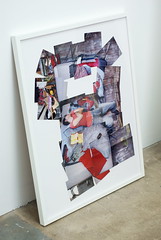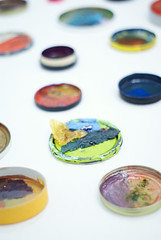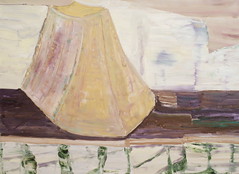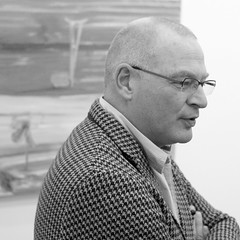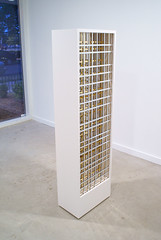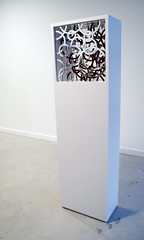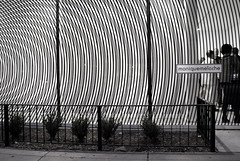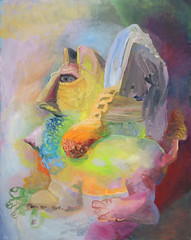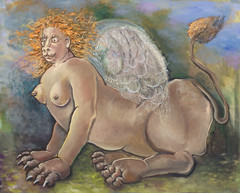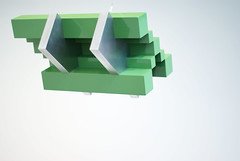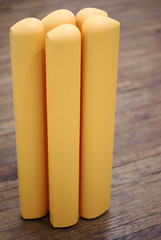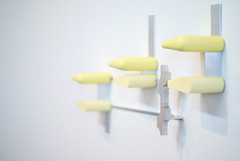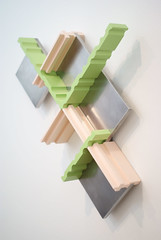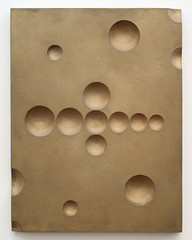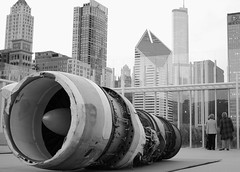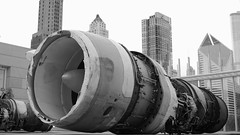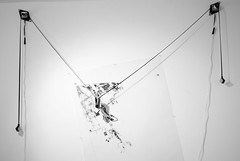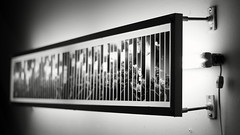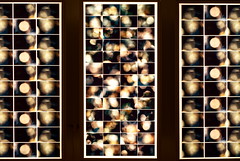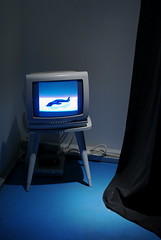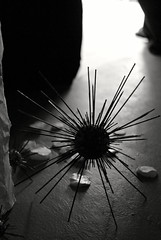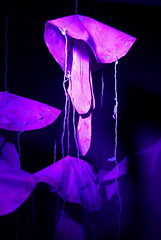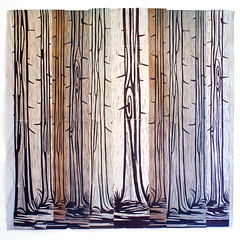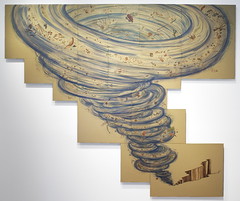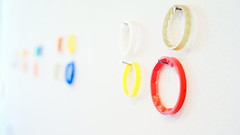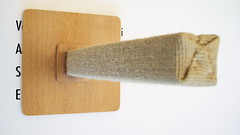It might be helpful to begin by remembering "
L.H.O.O.Q." from 1919, wherein Marcel Duchamp seized a contemporary postcard print of Leonardo da Vinci's 1505 "
Mona Lisa," defaced it with a moustache and tiny beard, and situated the titular acronym below the subject's thus modified countenance.
Especially noteworthy in the context of this review is that Duchamp (often) found it expedient to employ a "readymade" artwork, i.e., an object pre-existing for some distinct purpose, subsequently appropriated by the artist, and reintroduced as a beast of burden for his own ideology. Acknowledging his 1917 "Fountain" as the more common point of reference in such discussions, "L.H.O.O.Q." seems like the best precedent in this case, inasmuch as it involves a gender-conscious mockery of the viewer's attachment to the likeness of one traditional expression of the idea of the beautiful.
Said to have been born out of the perceived failure of European values evident after the tragedy of World War One, the echo of the strategic concern which informed Duchamp's activity (
Dada largely) has persisted now for nearly a century. And, tactical distinctions notwithstanding, nothing other than direct observation of the phenomena surrounding the
Rebecca Warren exhibition, which opened at the University of Chicago's
Renaissance Society on the third day of October, 2010, is needed to confirm that assertion.
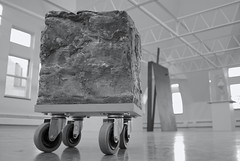
Whether Warren's intent is actually self-evident, the Society's own
Hamza Walker published the following teaching within his companion essay: "Her work is marked," Walker offers on her behalf, "by the appropriation (a polite way of saying chewing up and spitting out) of a squarely object-based tradition."[1] The text bounded by parentheses belongs to Walker; the quote is verbatim. Where that "object-based tradition" is abstract, Walker supposes that it has served "as a means of silencing culturally specific voices, including those of women."[2] And, looking at the historical representation of the human figure Walker perceives "a tradition in wholesale need of a woman’s deconstructive touch."[3] What ought one to make of Walker's handling of art history and Warren's relationship to it?
Looking around, Warren's past treatment by
Tate does seem to corroborate Walker's exegesis, stating that she: "intentionally misappropriates existing images by the accepted masters of figurative sculpture,"[4] and, "explores the degradation of established form."[5]
Too, in a description of Warren's concurrent display upon their own Bluhm Family Terrace, the
Art Institute of Chicago provides that: "She knowingly references the work of canonical male artists,"[6] while laboring to "disrupt entrenched notions of the classical ideal."[7] In fact, the very presence of Warren's sculptures upon said Terrace is given a gendered reading as they (Warren's sculptures) are called: "forceful counterpoints to Chicago’s renowned modernist skyline--itself dominated by works of the city’s greatest, mostly male architectural masters."[8]
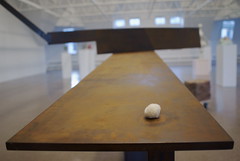
If one accepts--provisionally--what has been said to be the stance of the artist, it's good to continue the critical inquiry with a turn towards the formal qualities of the work. Frustratingly, some of the pieces are nearly formless. And it's difficult by means of any artwork to identify precisely which "canonical male artist" are her targets. Curious as well, given its repeated invocation by her interpreters, is that Warren's own gender isn't evident through an examination of the sculpture which is on display. In fact, the specific intent attributed to Warren (above) seems to be largely external to the visual experience of the exhibition within the gallery space. That being the case, one is made to wonder from what source/s the unanimous declaration of Warren's purpose has been derived.[9]
It's rather difficult to find (on-line) a clear statement of Rebecca Warren's philosophy of art--made by Rebecca Warren. Those statements which are available, and attributed to her, deal much more directly with the physical properties of the objects which she produces than with political conflicts between genders, or races, or classes. And where cleavages such as gender are invoked, she would (if reported correctly) seem to imply that said constructs are mutable (permeable, even) rather than fixed: "The various materials start off contrasting along gender lines––in their qualities of durability, brittleness, rectilinearity, and crumbliness. But these qualities are never stable for long, and they start to invade one another in ways that I find interesting."[10]
Not everyone shares Warren's interest. One local Arts Editor, Jason Foumberg of
Newcity, quickly made clear that he had grave reservations about the aesthetic nature of Warren's output. In his review Foumberg posited that: "The unquestioning acceptance of any old piece of shit--here, Warren’s--by The Renaissance Society, which now only produces four exhibitions per year, is a waste of the institution’s good name and resources."[11] The boldness of Foumberg's insight is laudable. Though, suggesting that Warren's exhibition is "a waste of the institution’s good name and resources," he seems to presuppose that Walker and the other members of the Society's staff failed to produce the outcome which they desired. Were it true, that would be odd. Everyone involved (at the Society) must have known aforehand that Warren's art was not per se beautiful or novel; yet, they went forward with the program. Why?
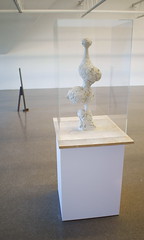
By happy coincidence, the contemporary episode of the Chicago-based, arts-focused podcast
Bad at Sports features an audio file containing an interview of School of the Art Institute Professor James Elkins by co-host Duncan MacKenzie. Therein, early in the exchange, Elkins makes reference to "the deepest division" within the arts academy being between those parties whose "ultimate aim is to produce an object," and those parties wishing to practice what "ultimately you might call politics."[12] With regard to the present undertaking, Elkins' pronouncement is timely and helpful. Though (as Elkins seems to acknowledge) the application of a strict dichotomy would prove false, his (Elkins') description of the factions (beautiful object producers v. anti-aesthetic political actors) locked in an unresolved conflict probably hints at the truth of the situation.
Tension has been building, notably since the 1960's, as artists, and ever more often curators, have employed the tactic of introducing garbage (sometimes literally) into gallery and museum spaces for the purpose of: (a) contesting the commodity value of art within the economic system of Capitalism; (b) blurring the distinction between the high and the low, the beautiful and the ugly, and so forth; (c) incrementally breaking traditional attachments (to property, family, religion, nation, etc.) in anticipation of the opportunity to introduce new orders.
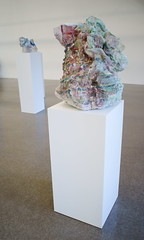
For example, Italian
Arte Povera might be described as a coming together of Dada's nonsensical, anti-establishment antics and a left-wing agenda for social change; in 1967 Germano Celant did refer to Marcel Duchamp by name in what's come to be called the Arte Povera manifesto.[13] Closer to home, one might also consider the tone of the activity even now ongoing within many of Chicago's apartment and not-for-profit galleries. While treating Lynne Warren and Mary Jane Jacobs' 1984 text "Alternative Spaces in Chicago," another Newcity Arts contributor, Dan Gunn, traced the evolution of those venues with roots in the 1970's which, he wrote: "grew out of a desire to show anti-commercial, ephemeral, or Feminist work."[14]
Ultimately, those three themes "anti-commercial, ephemeral, [...] Feminist" are more clearly evident in the curatorial choices and critical texts which involve Rebecca Warren than they are within the works involved in her exhibition. It seems ridiculous to accept that Warren has set herself against the Western tradition of making art objects--by making art objects in the West. The four distinct types of sculpture on display within the Ren's undivided chamber: (1) female figure; (2) abstract steel; (3) bronze cube; and (4) amorphous clay, function as parody only to the degree that the audience recognizes in their form the target of the parody, i.e., sculpture. In truth, she's engaged in a very conventional--one might even say conservative--enterprise. She produces sometimes delicate, sometimes costly, things which are shipped around the world for display in prestigious institutions. Her work is in important collections; she's won awards and critical acclaim. As ugly and imperfect as it might at times be, the "art world" is "working" for her. In the end, it's not in her self-interest to truly injure the system; it's only useful to tickle it.
[1]
http://www.renaissancesociety.org/site/Exhibitions/Essay.Rebecca-Warren.616.html
[2] Ibid.
[3] Ibid.
[4]
http://www.tate.org.uk/britain/turnerprize/2006/rebeccawarren.htm
[5] Ibid.
[6]
http://www.artic.edu/aic/exhibitions/exhibition/Warren
[7] Ibid.
[8] Ibid.
[9]
http://www.guardian.co.uk/artanddesign/2009/mar/22/rebecca-warren-serpentine-gallery-review
Above: Laura Cumming for a more formal and less gendered reading of Warren's work.
[10]
http://artforum.com/words/id=26507
Above: "As told to Lauren O’Neill-Butler" in Artforum.
[11]
http://art.newcity.com/2010/10/11/review-rebecca-warrenthe-renaissance-society/
[12]
http://badatsports.com/2010/episode-267-james-elkins-and-the-stone-summer-theory-institute/
Above: Hear 04:17 - 06:01 within the audio for Episode 267.
[13]
http://www.flashartonline.com/interno.php?pagina=articolo_det&id_art=352&det=ok&title=ARTE-POVERA
Above: Archive of Flash Art n.5 - 1967.
[14]
http://www.dangunn.com/entries/articles/arc_pr.html
See also:
http://proximitymagazine.com/2009/07/artist-run-spaces-a-brief-history-since-1984/
Rebecca Warren
October 3 - December 12, 2010
Tuesday - Friday: 10:00 am - 5:00 pm
Saturday, Sunday: 12:00 am - 5:00 pm
Closed Mondays
The Renaissance Society
Bergman Gallery, Cobb Hall 418
5811 S. Ellis Avenue
Chicago, Illinois
Exhibitions at The Renaissance Society are free of charge.
http://www.renaissancesociety.org
"Rebecca Warren is organized by The Art Institute of Chicago and The Renaissance Society at The University of Chicago. The Renaissance Society presentation is generously funded by the Stanley Thomas Johnson Foundation, The Henry Moore Foundation, and The British Council. The presentation at the Art Institute of Chicago is generously funded by the Bluhm Family Endowment Fund, which supports exhibitions of modern and contemporary sculpture on the Art Institute's Bluhm Family Terrace.
Ongoing support for programs at The Renaissance Society is provided by Alphawood Foundation; the CityArts Program of The Chicago Department of Cultural Affairs, a municipal agency; Christie’s; The Danielson Foundation; The John R. Halligan Charitable Fund, the Illinois Arts Council, a state agency; The MacArthur Fund for Arts and Culture at Prince; Chauncey and Marion D. McCormick Family Foundation; Nuveen Investments, the Provost’s Discretionary Fund at The University of Chicago; Pritzker Foundation; The Andy Warhol Foundation for the Visual Arts;The Siragusa Foundation; and our membership."
Related Posts:
http://paulgermanos.blogspot.com/2011/06/review-william-j-obrien-renaissance.html
"Review: William J. O'Brien @ The Renaissance Society," June 11, 2011
- Paul Germanos
